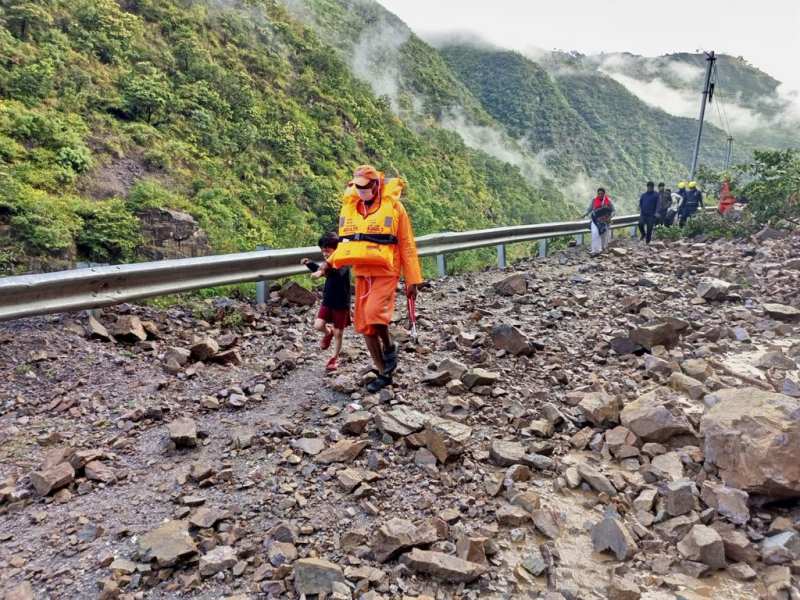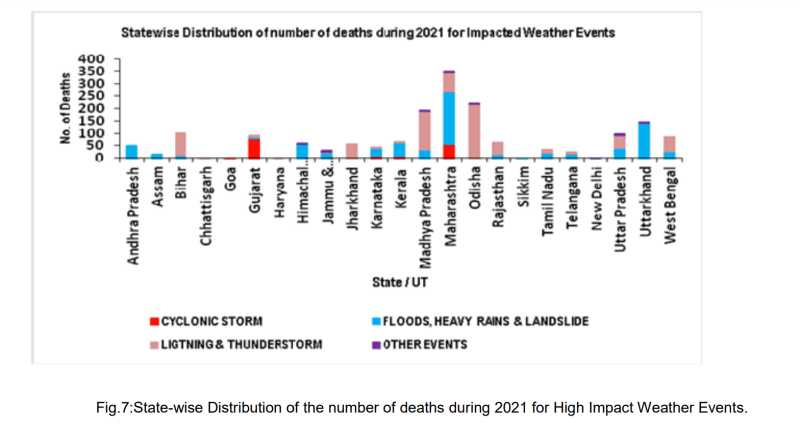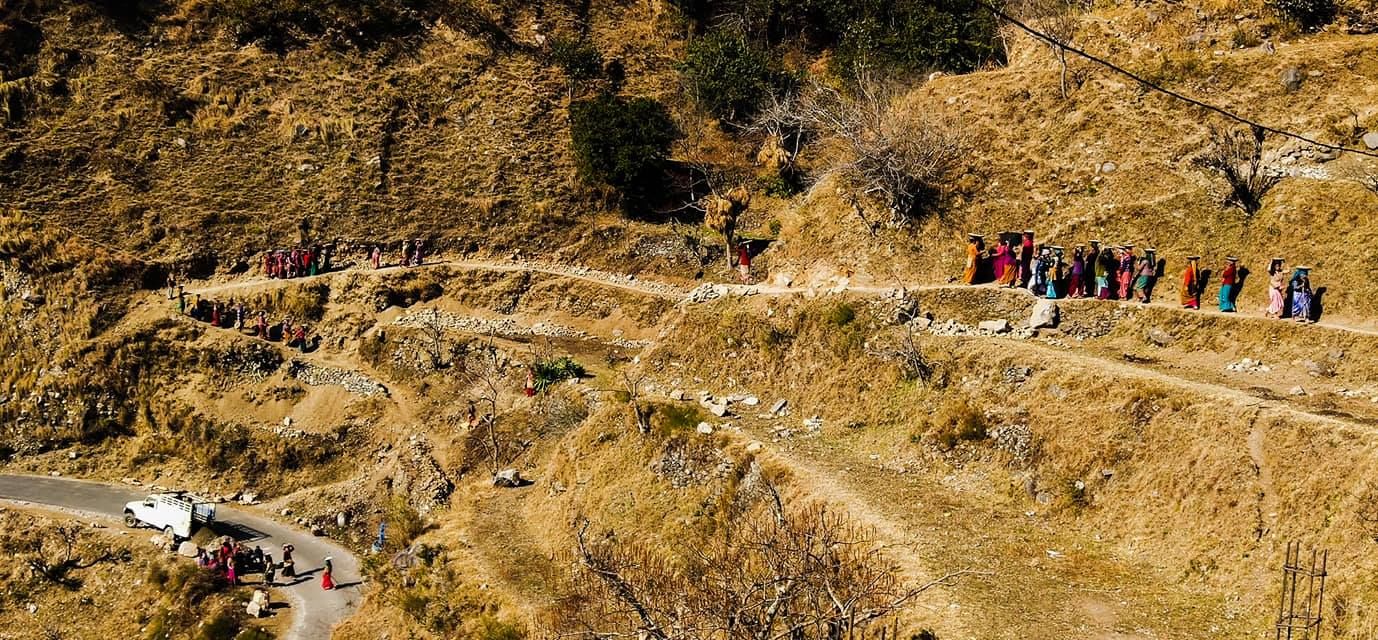Uttarakhand Elections 2022: Climate change-induced extreme events not a poll agenda for political parties
From Chamoli landslide to Kedarnath floods, Uttarakhand has witnessed umpteen disasters in recent times that have wreaked havoc on its population. Yet none of the major political parties – BJP, Congress and AAP – have raised environment protection as an election issue. Experts warn that climate proofing of infrastructure, investments, and policies in the Himalayan state is crucial.


Over 85 per cent of districts in Uttarakhand, which are home to close to nine million people, are hotspots of extreme floods and other climate change-induced weather events. Photo: By arrangement
The Himalayan state of Uttarakhand is one of the five poll-bound states in the country with assembly elections set to be held in the hill state next month on February 14. Over 85 per cent of districts in Uttarakhand, which are home to close to nine million people, are hotspots of extreme floods and other climate change-induced weather events.
Yet, none of the leading political parties in the fray have much to offer to their electorate on this burning issue, which is not just an ‘environment’ issue but also affects farming, livelihood, migration, and health of the residents of the state.
Last week, Chamoli-based non-government organisation, Aagaas Federation, in collaboration with several other local organisations, started a campaign that is based on the premise of — ‘If your party is not talking about a policy to protect the environment, then please don’t ask for votes’.
Also Read: Uttarakhand: The Himalayan state is besieged by extreme floods and increased droughts
J.P. Maithani, founder of Aagaas Federation, told Gaon Connection that politicians in the state lack the vision to address the ramifications of the climate crisis. “Local MLAs and MPs lack vision to take up this issue. None of them know how to develop the state without keeping in mind the ecological ramifications of unplanned developments,” Mathiana said.
“A realisation has dawned upon people in cities like Dehradun that the political party that has a plan with respect to the environment crisis that we are currently facing will be voted to power,” the founder added.

Gaon Connection spoke to the spokespersons of the three leading political parties in Uttarakhand — BJP (Bharatiya Janata Party), Congress and AAP (Aam Aadmi Party) to understand what they had to offer on the issue of responding to climate change and its impact on the hill state.
While all the three spokesperson acknowledged that climate change is a rising concern in the hill state, none of them shared any concrete plan on the measures their party shall undertake if voted to power in the assembly elections 2022.
‘Environment important issue but there are other issues that need attention’
Elaborating on the steps taken by the ruling BJP government, Dehradun-based Vinod Suyal, BJP spokesperson, told Gaon Connection, “In view of the disasters that Uttarakhand witnessed last year (2021), we have set up earthquake predicting radars on a large scale across the state since Uttarakhand is a sensitive state which is prone to disasters. To predict disasters beforehand, many efforts are being taken at state and national level.”
On the other hand, Garima Dasoni, the spokesperson of the Congress party, told Gaon Connection that while the party sees climate change as an important issue, there are other important issues they will be focusing on.
“I don’t think we are going to take it [climate change issue] up because there are major issues we want to talk about like employment, inflation, and law and order, and condition of farmers in the state. These are big enough issues,” Dasoni said.
The Congress party spokesperson went on to add: “We are not going to endanger the green cover of the state under the guise of development. We will take steps to safeguard the environment of Uttarakhand and we are in consultation with experts regarding proper urbanisation of the state.”
Apart from BJP and Congress, AAP is also fielding candidates in the upcoming Uttarakhand assembly elections.
Talking to Gaon Connection, Ravindra Singh Anand, the spokesperson of AAP, said, “Despite being a “double-engine” government, BJP failed to take concrete steps regarding disaster management. It’s necessary that we elect a government that has good intentions with regard to climate change.” According to him, AAP is the only party that indulges in kaam ki raajneeti (politics on the basis of work done) rather than petty politics on the basis of religious grounds.
While Anand listed a slew of schemes that AAP is planning to introduce in its manifesto including provision of free electricity, payment of employment allowance to unemployed youth, and free pilgrimage service for senior citizens in Uttarakhand, he didn’t reveal any structured policy on the issue of climate change and ecological conservation.
Also Read: Uttarakhand: The Himalayan state is besieged by extreme floods and increased droughts
“Disaster management is an important issue and if one can solve that issue, it will also lead to an increase in tourism. For the rest of the issues, we will be revealing our plan when we release our manifesto in a few days,” Anand told Gaon Connection.
All the three parties are yet to release their election manifesto for the upcoming elections.
“At least 3,000 villages in Uttarakhand lie in vulnerable areas. Their topography and locations are highly vulnerable and have been largely impacted by disasters,” SP Sati, head of the Department of Basic and Social Science, College of Forestry, Ranichauri, Tehri Garhwal, told Gaon Connection.
Expressing regret over the sorrowful state of affairs regarding climate change, Sati said: “It’s unfortunate that this issue is not being taken seriously in the current election discourse by any political party.”
Massive flash floods and acute droughts in Uttarakhand
Over 85 per cent of districts in Uttarakhand, which are home to close to nine million people, are hotspot of extreme floods and associated events, according to a recent analysis by Council on Energy, Environment and Water (CEEW India), a New Delhi-based think tank, which highlighted how vulnerable Uttarakhand was to climatic changes.
The Himalayan state has recorded an increase in both extreme floods and droughts in the last five decades, warn the experts.
Since 1970, there has been a four-fold increase in extreme flood events in Uttarakhand. A similar increase in associated events such as landslides, cloud bursts, and glacial lake outbursts has been recorded. Chamoli, Haridwar, Nainital, Pithoragarh, and Uttarkashi districts are most vulnerable to extreme floods, according to CEEW India.
The analysis by the Delhi based think-tank found a two-fold increase in droughts in the state during the same period. Over 69 per cent of districts in the state are now drought-prone. In the last decade, floods and droughts occurred simultaneously in Almora, Nainital, and Pithoragarh districts. This further complicates risk-informed decision-making for policymakers and response teams, according to the think tank.

“Uttarakhand’s vulnerability to climate events will hinder any developmental agenda due to the quantum of loss and damage that the extreme events will cause,” Abinash Mohanty, Programme Lead at CEEW told Gaon Connection. “So, it is imperative to include in election manifestos so that lives, livelihoods, infrastructures and economic sectors are insulated from these climate extremities,” he added.
Also, a media briefing released by Climate Trends, India, in October 2021, summarised the extreme rainfall the hill state witnessed in 2021, late withdrawal of monsoon was the key reason behind overflowing of rivers and lakes which led to floods across the state.
As per the Statement on Climate of India during 2021 released by India Meteorological Department, Uttarakhand witnessed loss of 143 lives due to floods, heavy rainfall and landslides in 2021. The tally was the second highest in India after Maharashtra where 215 people lost lives due to the same reason.

Heavy rainfall-induced disaster isn’t the only reason behind loss of lives and property. Earlier in February 2021, an avalanche in Chamoli district had led to flash floods that killed over 200 people and washed away two hydropower projects.
Environmental migrants
Focusing on how climate issues are interlinked with other issues and need to be seen from a broader perspective, Anoop Nautiyal, the founder of Social Development for Communities Foundation, a Dehradun based not for profit organisation, said, “Currently, migration is taking place due to climate change but in the future, people might have to migrate because of disasters due to climate change.”
Nautiyal went on to say that in 2021, the Himalayan state witnessed a lot of disasters with high intensity. “People in disaster-struck villages might move out because they won’t be left with any other option,” he warned.
A 2021 study titled Locked Houses, Fallow Lands: Climate Change and Migration in Uttarakhand, India addresses the same issue of migration that Nautiyal mentioned.
The study, jointly conducted by New Delhi-based The Energy and Resource Institute (TERI) and Germany-based Potsdam Institute for Climate Research (PIK), highlighted that decreasing agricultural productivity was a major reason for migration in the state. It stated that in the past two decades a decline in agricultural productivity, due to climatic conditions, has added to the farm stress of the hill farmers and has contributed to outmigration.

Explaining climate change and its links with agriculture, livelihoods, and consequences for migration as a feedback loop, the 2021 study stated climate change impacts water and agricultural productivity which impact livelihood and household income leading people to migrate. This leaves behind fewer people to work on farms that leads to more migrations, abandoned fields and locked houses that turn villages into ghost villages.
“A focus on land use-based forest restoration could reverse the climate imbalance and help promote sustainable tourism in the state,” Mohanty suggested as one of the possible solutions to the problem of climate change in Uttarakhand. Equally important would be climate proofing of infrastructure, investments, and policies, he added.
“This is no more an option, rather a national imperative to tackle such extreme events and ensure minimal loss and damage. Policies should be targeted at enhancing adaptive and resilience capacities at various administrative levels” said Mohanty.

